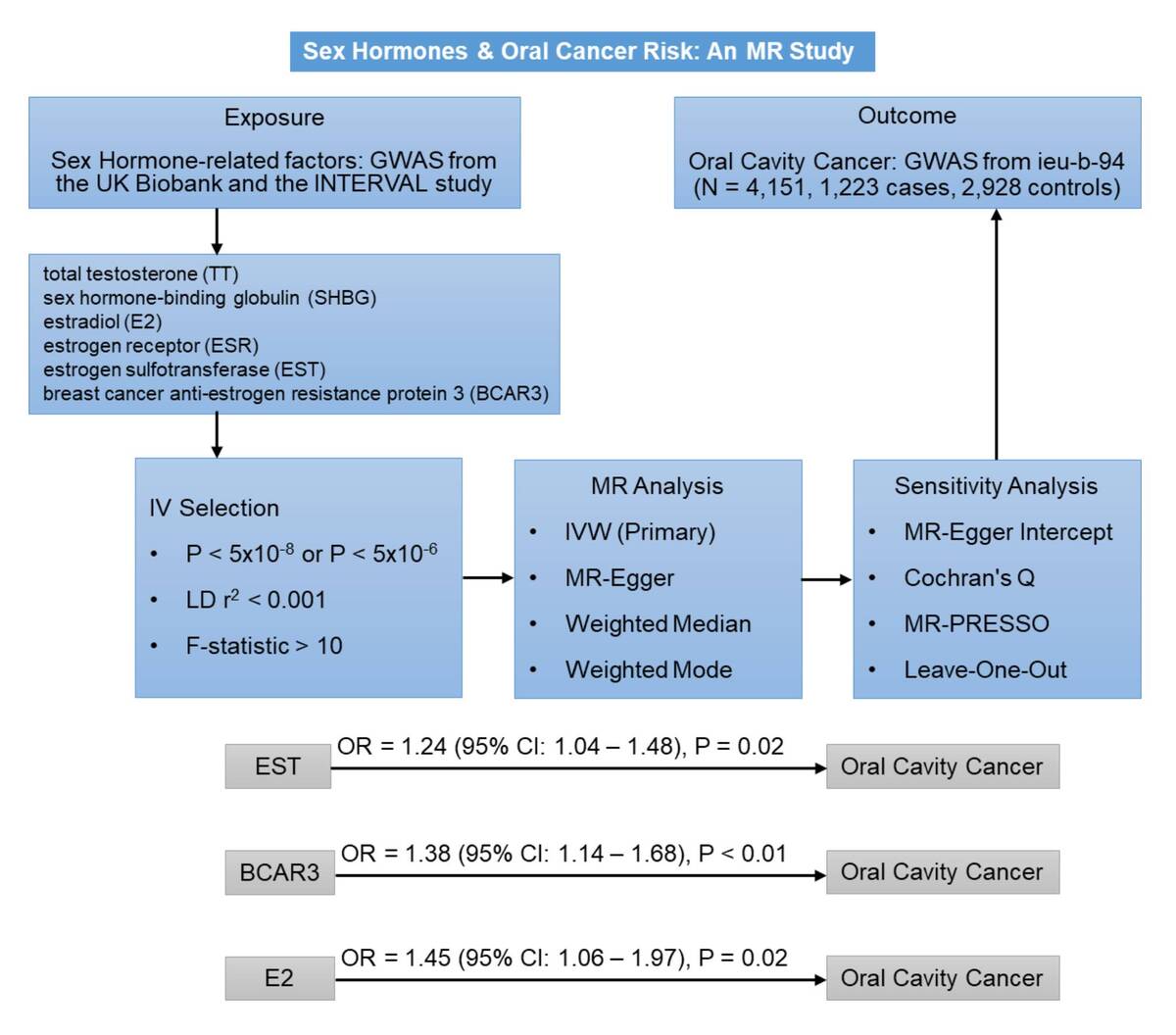Current issue
Archive
Manuscripts accepted
About the Journal
Editorial office
Editorial board
Section Editors
Abstracting and indexing
Subscription
Contact
Ethical standards and procedures
Most read articles
Instructions for authors
Article Processing Charge (APC)
Regulations of paying article processing charge (APC)
OTOLARYNGOLOGY / RESEARCH PAPER
Evaluating Causal Relationship between Sex Hormones and Oral Cavity Cancer: Mendelian Randomization Study
1
Department of Otolaryngology Head and Neck Surgery, Beijing Tiantan Hospital, Capital Medical University
Submission date: 2025-05-12
Final revision date: 2025-06-09
Acceptance date: 2025-06-16
Online publication date: 2025-06-22
Corresponding author
Lingzhao Meng
Department of Otolaryngology Head and Neck Surgery, Beijing Tiantan Hospital, Capital Medical University, China
Department of Otolaryngology Head and Neck Surgery, Beijing Tiantan Hospital, Capital Medical University, China
KEYWORDS
TOPICS
ABSTRACT
Introduction:
Observational studies on sex hormones and oral cavity cancer show inconsistent results. This two-sample Mendelian randomization(MR) study investigated potential causal associations between genetically predicted levels of six key sex hormone-related factors : total testosterone(TT), sex hormone-binding globulin(SHBG), estradiol(E2), estrogen receptor(ESR), estrogen sulfotransferase(EST), and breast cancer anti-estrogen resistance protein 3 (BCAR3), and oral cavity cancer risk.
Material and methods:
Summary-level data from genome-wide association studies(GWAS) for exposures and oral cavity cancer, obtained via the IEU OpenGWAS were analyzed using inverse variance weighted(IVW) as the primary method, complemented by weighted median, weighted mode, and MR-Egger regression. Sensitivity analyses included MR-Egger regression (directional pleiotropy), Cochran's Q(heterogeneity), and MR-PRESSO (outlier detection/correction).
Results:
IVW analysis linked genetically predicted higher EST (OR = 1.24, 95% CI: 1.04 – 1.48, P = 0.02) and BCAR3 (OR = 1.38, 95% CI: 1.14 – 1.68, P < 0.01) to increased oral cavity cancer risk. After removing one outlier SNP, a significant association was also observed between E2 and oral cavity cancer (OR = 1.45, 95% CI: 1.06 – 1.97, P = 0.02). No significant relationships were found for TT, ESR, and SHBG. These findings were consistent across weighted median, weighted mode, and MR-Egger regression. MR-Egger regression did not indicate significant directional pleiotropy. For E2, initial heterogeneity was resolved after outlier correction, while EST and BCAR3 showed no significant heterogeneity.
Conclusions:
To our knowledge, this is the first comprehensive MR study linking sex hormone-related factors (E2, EST, BCAR3) to increased oral cavity cancer risk. Further validation is needed to explore prevention and treatment implications.
Observational studies on sex hormones and oral cavity cancer show inconsistent results. This two-sample Mendelian randomization(MR) study investigated potential causal associations between genetically predicted levels of six key sex hormone-related factors : total testosterone(TT), sex hormone-binding globulin(SHBG), estradiol(E2), estrogen receptor(ESR), estrogen sulfotransferase(EST), and breast cancer anti-estrogen resistance protein 3 (BCAR3), and oral cavity cancer risk.
Material and methods:
Summary-level data from genome-wide association studies(GWAS) for exposures and oral cavity cancer, obtained via the IEU OpenGWAS were analyzed using inverse variance weighted(IVW) as the primary method, complemented by weighted median, weighted mode, and MR-Egger regression. Sensitivity analyses included MR-Egger regression (directional pleiotropy), Cochran's Q(heterogeneity), and MR-PRESSO (outlier detection/correction).
Results:
IVW analysis linked genetically predicted higher EST (OR = 1.24, 95% CI: 1.04 – 1.48, P = 0.02) and BCAR3 (OR = 1.38, 95% CI: 1.14 – 1.68, P < 0.01) to increased oral cavity cancer risk. After removing one outlier SNP, a significant association was also observed between E2 and oral cavity cancer (OR = 1.45, 95% CI: 1.06 – 1.97, P = 0.02). No significant relationships were found for TT, ESR, and SHBG. These findings were consistent across weighted median, weighted mode, and MR-Egger regression. MR-Egger regression did not indicate significant directional pleiotropy. For E2, initial heterogeneity was resolved after outlier correction, while EST and BCAR3 showed no significant heterogeneity.
Conclusions:
To our knowledge, this is the first comprehensive MR study linking sex hormone-related factors (E2, EST, BCAR3) to increased oral cavity cancer risk. Further validation is needed to explore prevention and treatment implications.
Share
RELATED ARTICLE
We process personal data collected when visiting the website. The function of obtaining information about users and their behavior is carried out by voluntarily entered information in forms and saving cookies in end devices. Data, including cookies, are used to provide services, improve the user experience and to analyze the traffic in accordance with the Privacy policy. Data are also collected and processed by Google Analytics tool (more).
You can change cookies settings in your browser. Restricted use of cookies in the browser configuration may affect some functionalities of the website.
You can change cookies settings in your browser. Restricted use of cookies in the browser configuration may affect some functionalities of the website.



